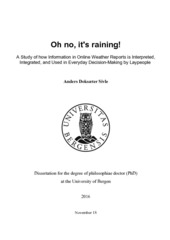Oh no, it’s raining! A study of how information in online weather reports is interpreted, integrated, and used in everyday decision-making by laypeople
Doctoral thesis
Permanent lenke
https://hdl.handle.net/1956/15226Utgivelsesdato
2016-11-18Metadata
Vis full innførselSamlinger
Sammendrag
Different people in different occupations depend on weather forecasts to plan their work and recreational schedules. People with no expertise in meteorology frequently interpret weather forecasts and uncertainty information. These non-experts apply their prior knowledge and experiences in a variety of fields and their abilities to synthesize different types of information to interpret forecasts. Initial studies of communication and the interpretation of forecasts and uncertainty information focused on separate pieces of information rather than the situations of ordinary users. In this study, situations of typical users are simulated to increase the ecological validity when examining how different user groups interpret, integrate, and use information from online weather reports in their everyday decision-making. First, qualitative interviews of twenty-one Norwegians from five different user groups (farmers, exterior painters, tour guides, and upper secondary school teachers and students) were conducted. Second, sixteen upper secondary school students participated in an eye-tracking study. Immediately after this study, the participants were asked to verbalize their thoughts (think out loud) when viewing the gaze data. Semi-structured interviews were conducted to ensure the collection of rich data. In this study, the participants were given weather forecasts from one selected online weather report (www.Yr.no), which served as a basis for both data collections. The verbal data were analyzed by assigning codes and categories to the transcribed statements. The main findings of the study are as follows: a) For each representation, such as tables, diagrams, numbers and symbols, a set of strengths and functions (affordances) was ascribed and exploited by the participants. b) Only part of the representations that provided forecast and uncertainty information at the website was used by each participant. c) Nuances such as color and the number of drops were important in the interpretations of the weather symbols and forecast uncertainty, which were sometimes interpreted differently than intended by the forecast provider. d) Prior knowledge affected the participants’ interpretations and even superseded the given information in apparent conflicts. e) The interpretations were also affected by the integration of information from different representations, which was performed to create a dynamic picture of the weather and to control and compare information. f) The decision-making process influenced the construction of different reading paths and the selections of representations in different situations. g) The participants used a varying amount of information in their decision-making; their selection was dependent on the importance of the envisaged activity and the weather conditions for the day. h) Additionally, in situations in which the participants had a lack of experiences, this lack provides a possible explanation for why part of the information was occasionally not understood and used. i) Evaluations of weather dynamics and the degree of certainty in the forecast were disregarded when quick decisions were made. Some implications of the findings for communication and future research are as follows: a) Providers of online weather reports should take care in the details of the information they present because such nuances may be interpreted as substantial information. b) Uncertainty information should be easy to understand and use, and the benefits of this information should be clear to enable users to interpret the degree of certainty as intended. c) Information communicated in online weather reports should enable the use of different decision-processes. d) A comprehensive use of multimodal information in communication appears to be an advantage when information is used by different users in different situations. e) However, some users should be guided and supported to facilitate the interpretation, integration, and use of information from multiple representations in situations where they lack experiences and/or aim for an elaborate decision process. f) One possibility to support persons that lack experiences and have low situation awareness might be to provide consequences and impacts of forecast weather. g) Notably, forecast providers should take into account the needs of the forecast users. h) To achieve this goal, users’ needs should be addressed in a coproduction process. i) Future studies should investigate the situations of typical users and different decision-making processes.
Består av
Paper I: Sivle, A. D., Kolstø, S. D., Hansen P. J. K., & Kristiansen, J. (2014): “How do laypeople evaluate the degree of certainty in a weather report? A case study of the use of the web service Yr.no”, Weather, Climate, and Society, Vol. 6: 399-412. The article is available at: http://hdl.handle.net/1956/9191Paper II: A. D. & Kolstø, S. D. “Use of online weather information in everyday decision-making by laypeople, and implications for communication of weather information”, Manuscript accepted for publication by Meteorological Applications. The article is available in the main thesis.
Paper III: Sivle, A. D. & Uppstad, P. H.: “Students’ meaning-making when reading multimodal science information”. Full text not available in BORA.
